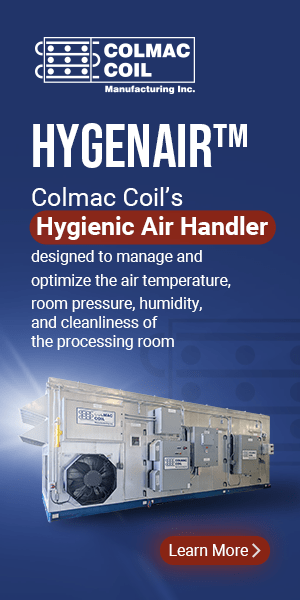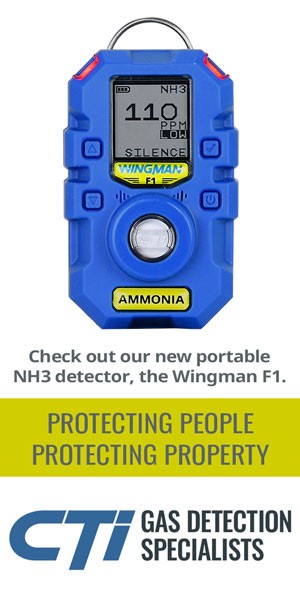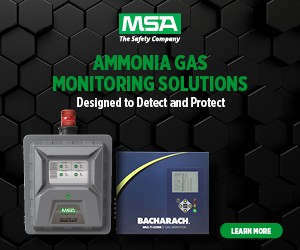New Report Offers Insights, Availability of and Use Cases for Natural Refrigerants
“New York state laws require a very ambitious greenhouse gas reduction, and they realize they must move even faster than what laws such as the EPA AIM Act rules are requiring – to meet their reductions,” said Gary Schrift, president of IIAR. “They are looking at ways to go further, and they know that refrigeration as an energy user and the release of synthetic refrigerants cause a great amount of GHG emissions.”
“The working group meetings were designed to bring sector-specific experts and stakeholders to the table to share the opportunities and barriers to transitioning to natural refrigerants.”
Danielle Wright, executive director of the North American Sustainable Refrigeration Council and co-lead of the working group Stationary Refrigeration: Retail Food and Other Commercial Refrigeration.
Effecterra prepared the report, New York State Assessment of Natural Refrigerants. Tristam Coffin, co-founder of Effecterra and president of sustainability, policy and technical services, said the report adds another layer of information that otherwise wouldn’t be available. “They tasked us to bring together a group of subject matter experts from a cross-sector who have gone through transitions and were familiar with the technologies available, deployed, and still needed” Coffin said. “There was an extensive group of people that participated.”
Effecterra held eight working group meetings with stakeholders to discuss the challenges and opportunities for natural refrigerants/heat transfer fluids by enduse. The working groups consisted of climate science experts, state policymakers, state and city officials, non-profit advocacy organizations, equipment manufacturers, and engineering experts who either directly work with natural refrigerants or have highlighted the need for addressing the barriers.
Different groups and experts co-hosted technical working groups. “The working group meetings were designed to bring sector-specific experts and stakeholders to the table to share the opportunities and barriers to transitioning to natural refrigerants,” said Danielle Wright, executive director of the North American Sustainable Refrigeration Council and co-lead of the working group Stationary Refrigeration: Retail Food and Other Commercial Refrigeration.
Topics included retail food and commercial refrigeration, industrial process refrigeration and cold storage warehouses, chillers, safety standards, and commercial and residential air conditioners and heat pumps. “It wasn’t just one single voice leading the conversation,” Coffin said. “We played a prime coordinator role, but it was purposefully a cross-sector collaboration.”
Dave Fauser, director of sales at Cimco Refrigeration and co-leader of the chiller working group, said the report shows that the world is changing and evolving, not just in the food and beverage space but also in data centers, electric vehicle manufacturing centers, and more. “All of these spaces are now looking to naturals. They are the solution if we want to fight climate change,” he said.
The report identifies natural refrigerant applications currently available, what’s coming to market, and possible projects identified by members of the technical working group. “This is the only report I’m aware of that provides a comprehensive assessment of the availability of natural refrigerants across all end-use sectors,” Wright said.
For Fauser, the big thing that stands out from the report is that natural refrigerants are a great solution. “We can use them in many different applications,” Fauser said. “When I started 20 years ago, if I’d brought these ideas up, I’d have been laughed out of the room. Now I’m reading these quite interesting ideas, and it is motivational to me. When we start to see them in other industries, it becomes exciting.”
One of the pilot projects addresses heating, cooling, and refrigeration for ice rinks. “We talked about our concept of Thermal Force One—a single unit that does heating and air conditioning using ammonia as a refrigerant,” Fauser said.
Cimco is working with a town in New York to build a multipurpose venue comprising an ice rink, gymnasium, indoor turf, daycare, and play structure. “What makes this technology interesting and why this would be a good study is the ice rink now becomes the byproduct,” Fauser said. “We can use that thermal energy, and we could heat or cool a neighborhood of homes. This is a case study we put forward to say natural refrigerants could replace furnaces.”
Other pilot projects address ammonia absorption heat pump systems for space-conditioning and water heating and combination heat pumps for space heating and domestic water heating using CO2.
Fauser said he encourages everyone in the industry to push the boundaries and share the success stories of moving into new markets. “That is what we need more than anything to fight climate change,” Fauser said.
There are various challenges preventing the greater adoption of natural refrigerants in the U.S., such as delays in adopting updated safety standards into state and local building codes and misinformation about the safety and energy efficiency of natural refrigerants. “We all know that natural refrigerants have risks, but so do all refrigerant options. Because natural refrigerants have been used for over 150 years, the risks are known, understood and mitigated by the use of modern technologies,” Coffin said.
“What makes this technology interesting and why this would be a good study is the ice rink now becomes the byproduct. We can use that thermal energy, and we could heat or cool a neighborhood of homes. This is a case study we put forward to say natural refrigerants could replace furnaces.”
Dave Fauser, director of sales at Cimco Refrigeration and co-leader of the chiller working group
The report found that standards need to be updated to allow greater use of natural refrigerants. “These changes don’t happen overnight, and it has slowed down the wider adoption of these types of refrigerants, mostly hydrocarbons,” he explained, adding that bringing industry participants together can help break down barriers. “It takes decades of work and international collaboration. We need to continue acting on that and pressing forward.”
Wright said greater coordination on building codes is needed. “Section 606.1.1 of the NYC Fire Code is a great example of a ridiculously outdated code that is obsolete but politically motivated,” she said. “Getting local codes updated to reflect the latest safety standards and model codes will take longer than it should unless there is active coordination at every level.”
Additionally, more clarity on per- and polyfluoroalkyl substances – known as PFAS – is needed. “Providing clarity on PFAS will give retailers and other end-users the certainty they need to weigh the costs and benefits of naturals against various alternatives,” Wright said. “Natural refrigerant solutions may have higher first costs compared to interim solutions but will prove to be more cost-effective if those solutions are eventually phased out as well.”
Some end-uses, such as commercial, industrial refrigeration, cold storage, and ice rinks, are well on their way to switching to naturals. However, they need greater incentive funding to help achieve economies of scale, retrofit existing buildings, and address workforce readiness challenges.
“End users are switching to naturals or have already, but there is a greater need for incentive funding. There are opportunities under the Inflation Reduction Act to support or help achieve the economies of scale necessary to continue to allow the market barriers to fall off and these solutions come to market,” Coffin said.
Coffin said one of the biggest challenges and opportunities is deploying natural refrigerants in AC and heat pumps, especially in the residential sector. “We need incentive funding and a paradigm shift in system design,” Coffin said, explaining that the U.S. has been addicted to low-cost high-efficiency rooftop units. “The combination of natural refrigerant heat pump solutions aren’t just possible. They’re here, and notably becoming commonplace in Europe.”
While the report was done in collaboration with New York State, it applies to anyone involved with refrigerants. “Other states can certainly use it, and companies interested in transitioning to natural refrigerants have been interested in looking at the report,” Coffin said. “In my mind, it is elevating the conversation. Everyone who is considering meeting their climate objectives needs to be thinking about these opportunities. They will be the clearest path to zero emissions going forward.”
Wright suggests anyone working in the refrigeration, air conditioning, and heat pump sector read the report. “I’ve referenced it in many conversations with national chain retailers, manufacturers, contractors, and government officials from other states working on refrigerant regulations,” she said.
Fauser said states that are moving forward on refrigerants can serve as an inspiration to others. “You have certain states like New York and California that are leaders. The innovators, early adopters, and trailblazers make it safe for the other states to follow behind,” he said. “People can say, ‘They did it, and now we’re going to go do it.’”
The report is available free online. Download the report at https://drive.google.com/file/ d/14udH0WJhMqdeez6sj_PeTkClORGLdHXS/view or https://www.linkedin.com/posts/effecterra_new-york-state-assessmentof-natural-refrigerants-activity7112918498481225728-1IqD.












